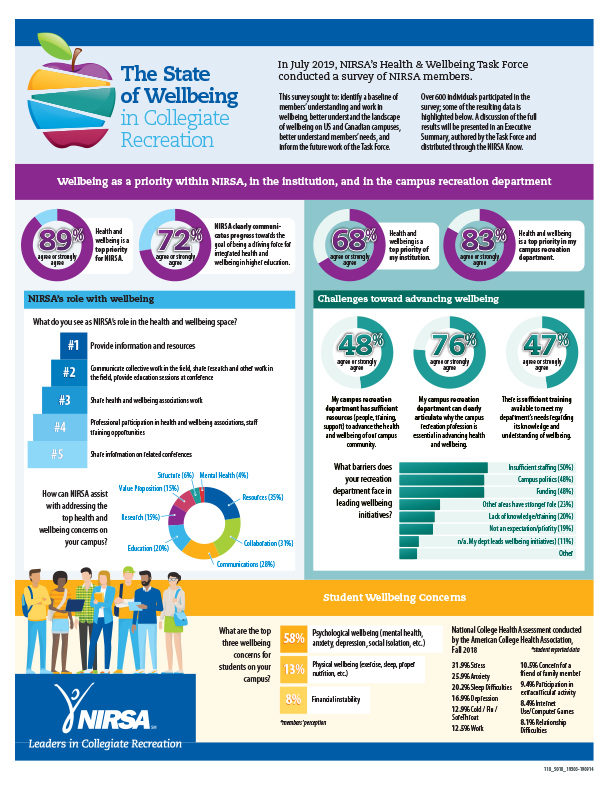2021 NIRSA Health & Wellbeing Survey Summary

Introduction
In late summer of 2019, the NIRSA Health and Wellbeing Task Force launched the first iteration of “The State of Wellbeing in Collegiate Recreation” survey. The purpose was to investigate members’ baseline understanding of health and wellbeing concepts, their work in supporting student wellbeing, and the underlying challenges of integrating wellbeing on U.S. and Canadian campuses. The 2019 survey revealed several important findings, including a gap between departmental and institutional level integration of wellbeing and a set of common barriers (staffing, campus politics, and funding) recreation departments face in this work. In response, the task force sought to help strengthen NIRSA’s inter-association collaborations and provide support for members through education, resources, and skill development.
Background
As part of an ongoing assessment strategy, the task force sent out an updated survey in 2021 to assess campus recreation’s progress in several areas:
- Respondents’ understanding of individual and collective roles in the advancement of health and wellbeing
- The integration of health and wellbeing on campuses
- NIRSA’s support for member needs in wellbeing work
- Respondents’ ability to articulate the impact recreation has on student wellbeing
It is important to note several factors impacted the 2021 survey results. During this time, the COVID-19 pandemic was a significantly influential variable in campus recreation’s work on campuses. It also impacted how collegiate recreation professionals viewed their roles and responsibilities regarding health and wellbeing, their ability to collaborate with campus partners and even within their own departments, departments’ access to funding and resources, and even overall participation across the organization. The 2021 survey yielded about half the participants of 2019; however, there is still value in reviewing the data—especially as it paints a picture of recreation’s role in wellbeing amidst a time of tumultuous change.
Survey
Participants
The 2021 State of Wellbeing in Collegiate Recreation Survey, which was sent to all NIRSA members, allowed for multiple responses per institution and yielded 297 responses. The invitation specifically encouraged NIRSA members to share the survey link with supervisors and influential colleagues in wellbeing across campus with the hopes of capturing senior leaderships’ perspectives. Most respondents work within campus recreation; however, there was a slight increase (3%) in response from campus partners outside the recreation unit. There was also a 10% increase in response from VP/AVP/Executive Director-level staff.
Similar to 2019, the 2021 survey was completed by an overwhelming majority of professional staff from four-year, public institutions with a student body of 10,000 or more. There was a relatively even distribution among NIRSA regions, including Canada, and most survey respondents report to the Division of Student Affairs.
Key Factors
Several questions were selected by the task force as key factors to monitor. These included:
- My campus recreation department can clearly articulate why the campus recreation profession is essential in advancing health and wellbeing. In 2019, 76% of respondents agreed with 30% strongly agreeing. There was a slight decrease in 2021 to 72% agreeing, 22% strongly agreeing.
- I believe my level of education on wellbeing is sufficient. This item has remained the same in 2019 and 2021, with 68% of respondents agreeing. Those strongly agreeing dropped 2% in 2021.
- Has your department been able to demonstrate its impact on student wellbeing? In 2019, this was a yes or no question, and 61% responded yes. In 2021, the question was altered to ask Describe how your recreation department has been able to demonstrate its impact on student wellbeing. Free responses were collected to learn more about how and to what extent departments were measuring student impact.
- Number of institutions that have “Improving student health, wellness, and/or wellbeing” stated in their strategic plan, vision, mission, goals, or learning outcomes at the institutional, divisional, and/or departmental levels. In 2021, there was a 6% increase in institutions with health/wellbeing as part of their strategic plan. At the departmental level, integration with mission/vision (81%) and goal setting (64%) remains unchanged. However, only 54% of recreation departments have health/wellbeing incorporated into their own strategic plans.
- Number of institutions that have a special committee or task force dedicated to leading campus-wide wellbeing initiatives. There has been a 4% increase in the number of institutions that have a dedicated group of this type.
- Identification of the top three departments/areas in their delegated or perceived authority to lead wellbeing initiatives on your campus. While the top three units identified with authority (recreation, student health, and psychological services) remain unchanged from 2019 to 2021, there has been a 5% increase in perceived authority of the special committee/task force itself.
Survey Findings
Over the last two years, health and wellbeing has remained a top priority for more than 65% of institutions across the country. As institutions continue to acknowledge the impact wellbeing has on student performance and engagement, campus recreation departments have responded in tandem. 89% of recreation departments now identify health and wellbeing as a top priority; up 6% from 2019.
The prioritization of student health and wellbeing is actualized at institutions in several ways. The inclusion of the topic into organizations’ long-term planning demonstrates a commitment to the topic itself by providing resources to meet goals. While there was a positive change in the number of institutions incorporating health and wellbeing into their strategic plans (6%), at the recreation department level there was no change. At first glance, this seems like a deficiency, but when considering the increase in departments’ prioritization of health and wellbeing alongside the increase in inclusion of health and wellbeing into measures stemming from the division or unit level—such as learning outcomes (7%) and goals (1%)—this finding may be reflective of recreation departments relying on the strategic plans of their operational unit or division.
In the 2019 survey, recreation was identified as one of the top three units delegated or perceived to have authority to lead wellbeing initiatives on campus. Two years later, recreation maintains that ranking. However, in that same period, special campus-level health and wellbeing committees or task forces have increased from 15% to 20%. It appears that many campuses are moving towards a collaborative approach with a designated backbone support group. This strategy may signal increased adoption of wellbeing frameworks, or it may simply be derived from the need to share responsibilities and resources. As campus-level groups are evolving, recreation departments report increasing their collaborations with other departments (91% in 2021; up 6%) and contributing staff members to wellbeing initiatives (70% in 2021; up 4%). Programming efforts remain unchanged.
If institutions and departments are making health and wellbeing a priority, there must also be investment in the necessary resources. Identified barriers to advancing wellbeing on campuses included insufficient levels of people, training, and support. In 2019, 48% of departments agreed or strongly agreed they had sufficient resources for health and wellbeing advancement. In 2021, that number dropped to 41%. Funding became the number one barrier to leading wellbeing initiatives (62% in 2021; up 14%). This may be a consequence of pandemic-related budget reductions/freezes and staffing losses. Conversely, there was a 5% increase in staff that strongly agree that they have sufficient training to meet the expectations of their role in advancing wellbeing. NIRSA conferences, webinars, and online meetings—along with advanced degrees and national certifications—were noted as playing a positive role in this advancement. Despite this improvement, training continues to be one of the top three challenges noted in 2021 for beginning or expanding wellbeing programs on campuses. This need may reflect the enduring and evolving field of wellbeing as well as the task force’s emphasis the last two years on increased member education.
Conclusion
The NIRSA Health and Wellbeing Task Force, using membership-driven data, has spent its first term setting up assessment, education, and outreach to meet the requests and needs of our members.
To date, the task force’s efforts have involved inter-association work with more than ten higher education and community partners. A key moment in the integration and alignment of these organizations was the publishing and endorsement of the Interassociation Definition of Wellbeing. 2021 survey data has revealed that 32% of campuses now use the definition as a standard/guideline to inform health and wellbeing efforts at their institution.
The task force has focused on ways to prepare NIRSA colleagues to become proactive innovators and practitioners in the wellbeing space by providing high-quality educational materials. Two specific achievements include the production of Promising Practices and the Wellbeing Briefing. Facilitated by the former Cross-Campus Integration Work Group (now Promising Practices Work Group), Promising Practices highlights institutions that demonstrate robust, integrated, and effective wellbeing programs with the goal of providing a road map of actionable steps that other institutions can explore and mirror to further their own initiatives. The former Member Resources Work Group (now Wellbeing Briefing Work Group) established the Wellbeing Briefing. Published once per quarter, the Wellbeing Briefing is a curated collection of relevant wellbeing trends and research applicable to a wide range of collegiate recreation purposes. Collections include articles, webinars, digests, best practice forums, and the identification of exemplary campus partnerships and collaborations.
Assessment plays a critical role in recreation, proving its impact on campus wellbeing both within NIRSA and to our higher education partners. The “State of Wellbeing in Collegiate Recreation” survey has been essential in the development of key factors to monitor, which will illustrate NIRSA professionals’ confidence in their wellbeing knowledge, application of health and wellbeing principles, expanded collaborations across campus, and ability to generate positive impact. With funding identified as a barrier to expanding wellbeing work, further research and assessment done by NIRSA and individual departments may provide administrators with the necessary evidence to support additional funding.
As the next term of the Health and Wellbeing Task Force is underway, the group’s main focus areas are equity, diversity, and inclusion; education and resources; research and assessment; and external partnerships. Under this model, the Promising Practices and Wellbeing Briefing resources will continue, while each of the four focus areas continues to evolve in response to member needs. It is expected that “The State of Wellbeing in Collegiate Recreation” survey will be reviewed by this new team, evolved as needed, and continue to be administered in the years to come.


